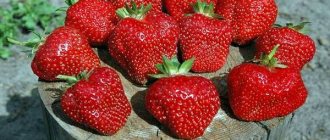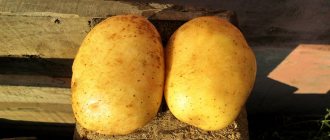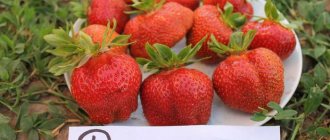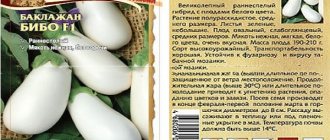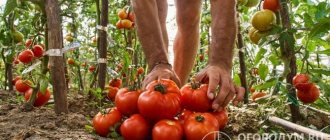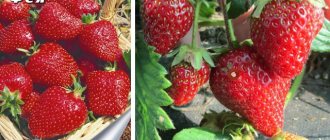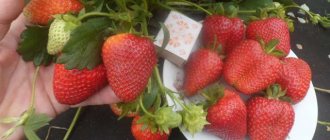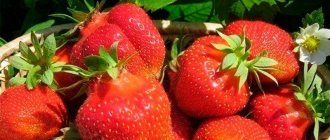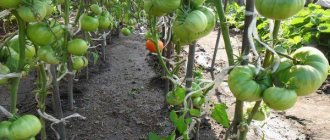History of the variety's creation
The Russian breeder G.D. Aleksandrova from the city of Pushkin has developed more than one strawberry variety, including Divnaya. It was created at the beginning of the last quarter of the last century and is recommended for growing in garden beds and in greenhouse conditions. But many lovers of this berry crop grow it even in apartments on the windowsill.
Photo of strawberry Divnaya
This breeder used the following varieties of strawberries as “parents”:
Festivalnaya and Holiday, from which Divnaya received only positive qualities.
This strawberry variety was added to the State Register (updated) in 2008
with a note that this berry crop can be grown on large farms, as well as in garden plots.
Advantages and disadvantages of technology
Over the years of successful use of the Frigo strawberry growing technology, it has proven its effectiveness, which is primarily due to its positive qualities.
- The undeniable advantages of this method of growing crops include the following characteristics:
- possibility of year-round cultivation of berries;
- compact dimensions of planting material;
- excellent adaptive qualities that allow you to grow Frigo strawberries in almost any conditions (this is explained by the presence of only a root system and rudimentary leaves on the seedlings);
- absence of disturbances in the biorhythms of cultivated plants during their storage;
- the ability to adjust the timing of planting strawberries in a permanent place of growth (this way you can avoid the effects of spring frosts);
- high crop yields;
- excellent level of drought resistance of plants.
Did you know? Strawberries are a storehouse of vitamin C
By eating only 100 g of berries a day, you will provide the body with 98% of the daily requirement of this important element.
- Unfortunately, for all its positive qualities, Frigo strawberries also have some less attractive characteristics, the main ones of which are:
- high cost of processed planting material and equipment for its productive storage;
- difficulties in applying the technology in the northern regions of the Russian Federation.
With a responsible approach to the use of Frigo technology and sufficient funding, it can be an excellent solution for increasing the abundance of harvested strawberries, which is especially valuable when cultivating them on an industrial scale.
Strawberry Divnaya: description of the variety
The Divnaya strawberry ripens in the first ten days of June in most Russian regions, and in the south of the country the harvest from this strawberry plantation is harvested in the last ten days of May.
The bushes of this strawberry variety are above average in size, strong and strong, erect with a large number of leaves. The foliage is large, slightly wrinkled, with a characteristic gloss, has no pubescence, the color is a rich emerald color.
STRAWBERRY DIVNAYA - variety description - video
Each plant produces a large number of strong flower stalks that do not grow higher than the leaves. Even under the weight of the harvest, the stems with berries do not lie on the soil, which is one of the undeniable advantages of the variety.
The flowers are large, self-pollinating, collected in inflorescences. To pollinate the Divnaya strawberry bushes, you do not need insects or the presence of other strawberry varieties nearby.
On a note!
Each Divnaya strawberry bush produces a large number of mustaches during the season - large, colored brown with a reddish tint.
The shape of the fruit can vary from blunt-conical to oval depending on growing conditions, including weather conditions, soil composition and further plant care. But most often the berries are approximately the same size, cone-shaped with blunt tips, without a neck.
Good varieties of strawberries:
Strawberry Sensation Strawberry Elvira Strawberry Alba
The first ripe berries are flat, very elongated, with a lot of folds, they are larger than subsequent fruits.
On average, the weight of the berries reaches 25 g, so the Divnaya strawberry variety is classified as large-fruited. The first fruits are larger, can reach 30-35 g. The last berries are much smaller, weighing about 15-20 g
. The skin of the fruit is quite dense, bright red in color, and becomes cherry when overripe. The pulp is slightly compacted and has no voids or coarse fibers inside.
The seeds are yellow in color, small, pressed into the skin, their number on each berry is average.
The taste of ripe Divnaya strawberries is excellent, tender, sweet with a slight sourness, the berries literally melt in your mouth. Ripe strawberries have a pronounced strawberry aroma.
Ripe strawberries contain:
- sugars – up to 5.8%;
- acids – 1.7%;
- ascorbic acid per 100 g of product – 44 mg.
The separation from the stalks of ripe berries is dry, so the fruits tolerate transportation well at different distances without releasing juice, and can also be stored in appropriate conditions for up to several days.
This variety of strawberries has good resistance to cold and can withstand frosts down to -25 degrees Celsius without shelter.
But you need to be wary of freezing of the buds when growing this berry crop in Siberia and the Urals, where return spring frosts often occur during the flowering period of the Divnaya strawberry.
Since the bushes of this berry crop produce a large number of runners per season, problems with the further propagation of Divna usually do not arise.
The Divnaya strawberry is also distinguished by its resistance to periods of drought, for which it is valued by gardeners from the southern Russian regions.
Further agricultural technology
Octave requires the gardener to carry out the following maintenance work.
Watering
The size of the berries and their taste directly depend on the regular supply of moisture. Watering begins at the end of April. For 1m2 you will need about 10-12 liters of water
It is important that the liquid is not cold
The frequency of moisture injection depends on weather conditions. On average, watering is carried out once every 10-14 days. In hot weather, the frequency is increased to 2-3 times a week. From August to October, it is enough to moisten the beds 1-2 times a week.
It is better to carry out work in the morning, avoiding water getting on the green mass and inflorescences when watering. Before flowering, the best option for introducing moisture is sprinkling; when the bushes bloom, it is recommended to resort to the drip irrigation method.
Fertilizer
Octave especially needs potassium and nitrogen supplements. You can alternate foliar and root application of fertilizers.
An approximate scheme for introducing nutrients will be as follows:
- in the spring, you can use a solution based on ammonia to water the beds (40 ml per 10 liters of liquid) or apply fertilizer under the roots in liquid form, using a herbal infusion, choosing juicy greens for it;
- during flowering, it is recommended to use mineral or organic potassium supplements, for example, potassium humate;
- In summer, it is worth using wood ash as a fertilizer, spraying the plantings with boric acid, honey water, or applying complex store-bought fertilizers.
Mulching
To exclude regular weed removal from the list of mandatory gardening tasks, strawberry beds should be covered with a layer of organic mulch - hay or straw. As an alternative, agrofibre can be used. Additional shelter in summer creates shade, as a result the soil overheats and dries out less, and weeds do not grow under it. In addition, agrofibre or dry grass protects the crop from contamination.
Trimming
Experienced gardeners regularly remove old green mass and excess tendrils. At the same time, you should not cut the sheets to the very base. Dry leaves and green mass with signs of wilting must also be removed.
Transfer
In the 4th-5th year, the variety’s ability to produce growth decreases, the reason for this is the depletion of the soil in which it develops. Therefore, after 4 seasons, it is recommended to transplant it to a new place in the garden. Such work can be planned for spring or late summer.
Plants are removed from the ground and the root system is shortened by a quarter. Before rooting in a new place, they are kept for some time in a manure-clay mash.
Preparing for winter
In the fall, after trimming excess green mass and tendrils, the variety must be fed, the soil in the beds loosened, and watered with potassium permanganate. To protect against freezing, cover with non-woven material or use dry leaves and straw. A shelter made of pine needles can protect the plantings from severe frosts.
Advantages of strawberry Divnaya
Experts include the main advantages of this berry crop:
- good yield;
- early fruit ripening;
- approximately the same size of ripe berries and good taste of Divnaya strawberries;
- versatility of using the harvested crop;
- good resistance to periods of drought and cold;
- ripe fruits tolerate transportation well over different distances and can be stored for quite a long time in appropriate conditions;
- mustaches are actively formed throughout the season, so gardeners always have planting material for propagation;
- variety resistance to verticillium and gray rot.
Among the disadvantages of the Divna strawberry, it should be emphasized:
- when grown in regions with a cool and rainy climate, the berries of this variety become tasteless and too watery;
- the berries become smaller at the end of the season;
- The fruits do not always have the same shape, which negatively affects their commercial qualities;
- have to deal with excess mustache during the summer.
Positive and negative aspects of berry culture
Strawberries of the Divnaya variety have the following advantages:
- taste and aroma of berries, like strawberries;
- high crop yield;
- increased resistance to some diseases that affect strawberries;
- unpretentiousness to the environment;
- increased resistance to frost and dry climates;
- large berry size;
- possibility of long-term transportation and storage;
- simple plant propagation.
Among the disadvantages, gardeners note:
- susceptibility of the taste of berries to increased moisture;
- uneven shape of the fruit, which spoils the presentation;
- With each subsequent harvest in the year, the berries begin to become smaller.
Agricultural technology for growing strawberries Divnaya
Planting Divnaya strawberry seedlings is not difficult. The main thing is to choose the right place for the strawberry plantation and plant the plants according to the instructions.
Strawberries for beginners. Growing secrets - video
[media=
https://youtu.be/N5l0W3wEfZI
]
Selecting a site for planting
The place for planting this variety should be illuminated by sunlight throughout the day and be protected from strong gusts of wind. But a slight draft in the beds with Divnaya strawberries is only welcome.
The soil on the site should be light and loose; before planting, organic matter and complex mineral fertilizers must be added to it so that it is fertile.
Important!
Divnaya strawberries are not grown in lowlands, on heavy clay soils with constant stagnation of moisture and in areas where groundwater comes too close to the surface of the earth - increased soil moisture can negatively affect the condition of the bushes of this berry crop.
Instructions for planting strawberries Divnaya
Before planting, carefully inspect the planting material - if the root system of the seedlings is longer than the above-ground part, it is shortened to the required length.
1-1.5 hours before planting, the plants are placed in a growth stimulator solution.
Planting scheme – no more than 4 per square area. If Divnaya strawberries are planted using the ribbon method, then the distance between neighboring bushes should be at least 0.35 m, and the row spacing should be at least 0.5 m.
Photo of strawberry planting scheme
The seedlings are placed in planting holes so that the roots are completely located in the soil.
The planting holes are filled with garden soil and compacted, then watered. To do this, you can use ammonium nitrate, diluting 1 tbsp. l. drug in a bucket of water. For each bush, 1 liter of this liquid fertilizer should be applied.
Important!
It is recommended to use ammonium nitrate solution for watering planted strawberries for 2-3 weeks after planting.
Landing Features
When preparing for planting, choose the appropriate timing and decide on the growing area. When choosing a location, consider the proximity to other crops
It is also important to select high-quality seedlings and properly prepare the seedlings for planting. Planting is carried out using precise technology.
Recommended planting times
Like other varieties, Divnaya strawberries can be planted in spring and summer-autumn. Optimal planting times depending on the chosen method:
- April 15 - May 5;
- July 25 - September 5.
Choosing the most suitable location
Strawberries can be planted in greenhouses and gardens. When planting outdoors, choose an open area without shade. The area must also be protected from drafts. The variety is undemanding to the soil, but it is worth choosing a loose, fertile substrate.
What crops can and cannot be planted next to strawberries
| Agronomists call good neighbors of strawberries: | Neighborhood with the following crops will be bad: |
|
|
Selection and preparation of planting material
When choosing a seedling, pay attention to its appearance. They say about the quality of planting material:
- branched root system;
- root length is at least 7 cm;
- bright green leaves;
- symmetrical and even sheet plates;
- absence of pale and dark spots on leaves and stems.
Before planting, it is advisable to treat the root system of the seedlings with the drug “Kornevin” according to the instructions.
Planting scheme
Seedlings are planted at a distance of 30–40 cm from each other. The landing pattern is as follows:
- Dig holes up to 10–20 cm deep.
- Place the seedlings in the holes.
- Fill the empty space with soil.
- Water each bush with ammonium nitrate solution (20 g of concentrate per bucket of water).
Further care for Divnaya strawberries
In order for the Divna strawberry bushes to be strong and strong and to produce good harvests every year, they need to be provided with good care throughout the season.
Irrigation regime
To prevent this berry crop from suffering from excessive soil moisture or too long periods of drought, it is better to install drip irrigation on the strawberry plantation, or to water the bushes using the sprinkling method.
Although the Divnaya variety does not suffer too much from periodic drought, regular watering still has a positive effect on the ripening of fruits and their taste.
Important!
During rainy periods, it is important to reduce the number of waterings so that the fruits do not become watery and insipid.
Caring for bushes throughout the season
In regions with a cold spring period, for example in Siberia, it is recommended to cover flowering strawberry beds with white agrofibre or install film greenhouses to protect the blooming buds from the cold.
Many gardeners, in order not to spend a lot of time weeding and loosening strawberry beds, prefer to grow this berry crop on special agrofibre.
CARE OF STRAWBERRY AFTER HARVEST - video
In spring and autumn, it is recommended to thin out the bushes, removing dried, diseased or damaged leaves and tendrils.
. It is also recommended to thin out the mustache during the season, especially if you do not plan to increase the strawberry plantation.
Feeding the berry garden
The feeding scheme for Divnaya strawberries is standard:
- in early spring, fertilizers containing nitrogen are applied to the bushes of this variety;
- during the flowering period, you need to apply fertilizers containing potassium, phosphorus, magnesium and iron;
- in the fall, in the process of preparing strawberry bushes for winter, they are covered with a thick layer of humus.
Preparing strawberries for winter
It is recommended to cover this variety of strawberries before the onset of cold weather only in regions with harsh winters.
Typically, the beds are covered with a thick layer of compost (or humus), which serves as a kind of “blanket” for the strawberry root system.
And on top, the strawberry bushes of Divnaya are covered with spruce branches; if necessary, metal arcs are installed on top, onto which agrofibre is stretched.
Useful article:
Preparing strawberries for winter
Care
The culture is unpretentious in terms of agricultural technology; the main care activities will be the following work.
Watering
It is best to water the hybrid using the sprinkling method; you can also resort to drip irrigation. The frequency of moisture introduction will depend on weather conditions; on average, the beds are watered 2-3 times a week throughout the summer. In autumn, it is enough to moisten the plantings 1-2 times every 7-10 days.
Fertilizers
The quality and quantity of the harvest will be affected by timely introduced fertilizing. The hybrid will require additional nutrients, which are added according to the following schedule:
- in spring it is necessary to focus on nitrogen-containing complexes;
- during the flowering and berry filling phase, it is recommended to introduce root fertilizers with complex compounds (phosphorus, magnesium, iron, potassium, etc.);
- After harvesting at the end of summer or beginning of autumn, a layer of compost or humus is laid between the bushes.
Mulching and covering beds
It is best to grow Divnaya in beds covered with agrofibre or hay or sawdust. In this way, the development of weeds can be avoided, as well as maintaining a sufficient level of moisture in the soil and protecting the crop from contamination. Most often, the beds are covered with black spunbond.
Trimming
It is important to monitor the condition of the plants, promptly removing dry and damaged leaves. The number of developing tendrils on plants is also subject to regulation.
Marvelous is characterized by the active growth of the latter; if they are not cut off in time, the bed will very quickly become overgrown with young crops. Excessive thickening will negatively affect the size of the berries and their quantity.
Harvest and storage
A sign that the berries are ripe will be their bright red color. It is best to harvest in the morning, using plastic or wooden containers. Store strawberries cool, at temperatures from 0C to +2C.
To ensure that the berries do not release juice and are also suitable for transportation, it is not recommended to wash them. Excellent freezing and suitable for canning. During heat treatment they retain their shape.
Preparing for winter
Marvelous needs additional protection from frost in the north and in the middle zone. The root system is covered with a layer of mulch or agrofibre is used; in the northern regions, special film covers for beds are created in the form of tunnels. The use of spruce branches will also provide reliable protection against freezing. In southern climates, they can be left to overwinter without additional shelter.
Before protecting the plant from frost, it is necessary to carefully remove all foliage from it, since under agrofibre or other material the green mass can become a fertile environment for the wintering of dangerous insect pests or pathogens of fungal infections.
Strawberry Wonderful: reviews from gardeners
Irina, 45 years old, Moscow region: I planted this variety of strawberries on my plot about 10 years ago - a neighbor in her summer cottage gave me a few mustaches. Over the course of several years, I planted Divnaya strawberries so that they already occupied several beds. Gradually, I removed other varieties of strawberries, since Divnaya suits me quite well with its unpretentiousness and productivity - currently I am collecting several buckets of ripe berries, tasty and aromatic, from the strawberry plantation. We have enough to eat, seal the jam, and freeze it for the winter. I would like to note that in the Moscow region, the Divnaya strawberry variety winters well without shelter and does not freeze.
Natalya, 50 years old, Rostov region: I have been growing Divnaya strawberries for 6 years now. I want to say that over the years she has had practically no illnesses and has calmly endured periods of drought, since I cannot come to the dacha as often as I would like. Despite this, the yield of the variety does not suffer greatly from lack of moisture. The variety reproduces easily, the mustache is enough not only for reproduction - I share it with my neighbors.
Over the past decades, breeders from around the world have developed many new varieties of strawberries, including remontant ones. All of them are distinguished by improved fruit characteristics, high yields, excellent presentation and taste of ripe berries. However, the Divnaya strawberry is still loved by Russian gardeners for its unpretentiousness, early ripening of aromatic and tasty berries and good yield.
Difficulties in growing
Sometimes difficulties may arise when growing Divnoye strawberries:
- lack of flowering - this can happen when the plant absorbs all the nutrients from the soil. To avoid this, you need to carry out periodic feeding;
- there are few berries and they are small - this is a consequence of a large amount of moisture that got on the flowers of the plant or the crop was planted too densely;
- the bush gradually fades - this sign indicates insufficient watering of the crop.
Disease and pest control
The culture is resistant to verticillium, gray rot and fungal spotting.
| Other diseases are dangerous for plantings, in particular: | Plant parasites can infect: |
|
|
To prevent and treat these diseases, it is necessary to use fungicides. Suitable products include Bordeaux mixture, Skor, Fitosporin. Use products according to instructions.
To prevent pest attacks, carry out preventive treatments with insecticides. For strawberries, the preparations Actellik, Karbofos and Aktara are acceptable.
Harvest and storage
The harvest is harvested when the berries turn bright red. After harvesting, store the fruits in the vegetable section of the refrigerator. The optimal temperature for storage is 0. +2°C. To prevent strawberries from drying out, place the harvested crop in a plastic container.
Strawberries are easy to grow. According to the experience of gardeners, bushes grow and bear fruit even in unfavorable conditions. However, it is better to care for the plantings according to the rules described above. For his labors, the farmer will definitely receive a reward in the form of a rich and tasty harvest.
Varietal features and characteristics
Strawberries of the Divnaya variety differ from analogues in the early dates of flowering and fruit ripening. Fully ripe berries appear in the first half of June, and in hot regions - in the second half of May. This feature of the crop is both a plus and a minus, since in areas with cold springs it is necessary to cover the plants so that the blooms do not die before they are fully formed.
The bush differs from other strawberries in its powerful stem, large number of leaves and tendrils. Despite this, the plant is quite compact, but due to its excessive density it is necessary to constantly trim excess shoots. A characteristic feature of Divna is the shape of the berry, which has a blunt-conical appearance. At the same time, the size and proportions of the fruits are constantly changing.
At the beginning of fruiting, most of the berries are elongated and heavy, and towards the end they become less long and smaller.
Bush size and leaf blade appearance
Divnoy strawberry bushes are tall (20-30 centimeters) with a powerful stem and a lot of foliage on it. The leaves are large, have a dark green color, a glossy surface with characteristic shallow wrinkles and denticles along the edges.
Flowering and pollination
The beginning of flowering directly depends on the weather conditions of the region in which the crop is located. Under the necessary climate and care conditions, strawberries begin to bloom in the first half of May.
The flowers of this variety are bisexual and therefore do not require additional pollination from other plants.
Ripening time and yield
The ripening period also depends on climatic conditions. With early flowering, the first fully ripened fruits will appear in the second half of May and early June. The yield of the variety is high, and at home you can collect about 1-1.5 kilograms of fruit from one bush. The average weight of the berry is 20-30 grams, but over time the fruit begins to shrink.
Taste qualities of the fruit and its further sale
Tasters rate the taste of Divnaya strawberries at 4.8 points out of 5 possible due to their pleasant and moderate sweetness, characteristic sourness and strong strawberry smell. Among the disadvantages, they note the not always attractive appearance, which is heterogeneous and can change every collection period. However, the berry is considered a serious competitor in taste to its Western counterparts.
Winter hardiness and drought resistance
This crop has increased resistance to cold climates and can withstand frosts from -20 °C to -25 °C without shelter. It should be remembered that strawberries are highly susceptible to frost in the spring, when inflorescences begin to form. The plant can also survive drought, but not for long, because then the crop begins to hurt, dry out and may die.
Immunity and susceptibility to disease and parasites
One of the advantages of the variety is its immunity to some diseases and parasites that affect other crops. Among the ailments, the Divnaya strawberry is resistant to:
- fungal spots;
- gray rot;
- verticellosis.
The strawberry variety Divnaya is susceptible to certain parasites:
- spider mite;
- nematode;
- slug.
To prevent damage by these pests, preventive treatment should be carried out.
